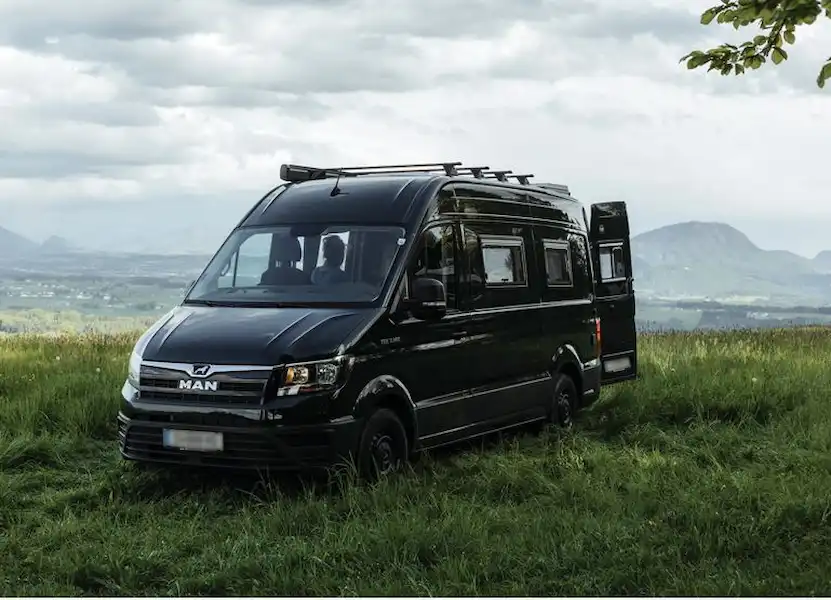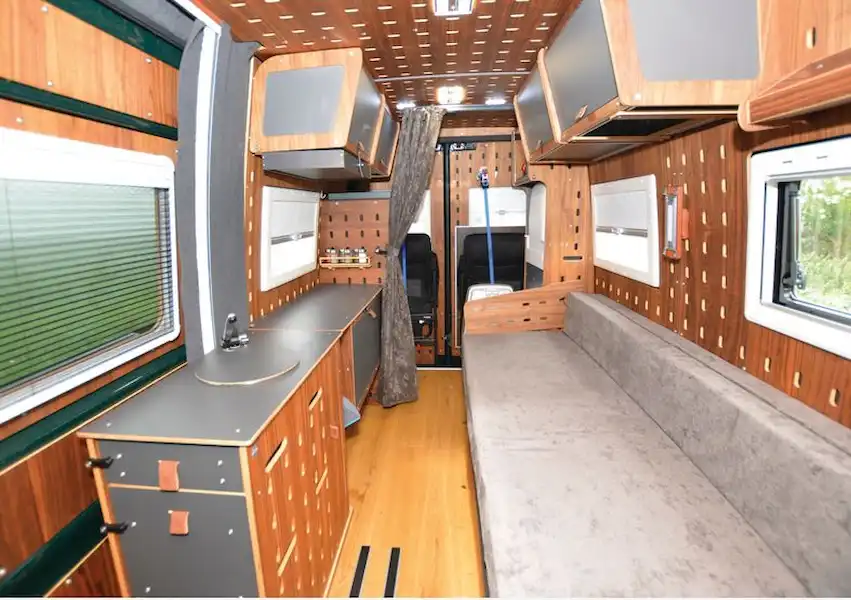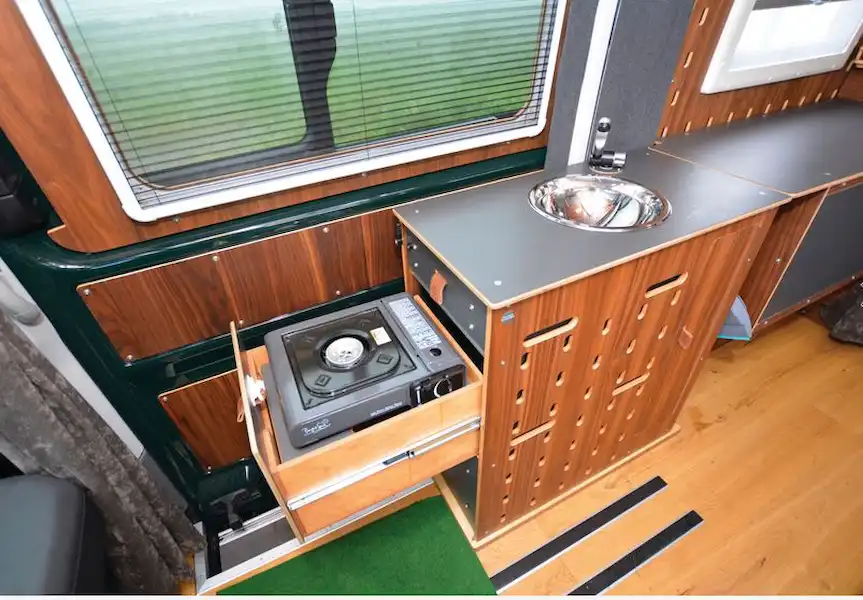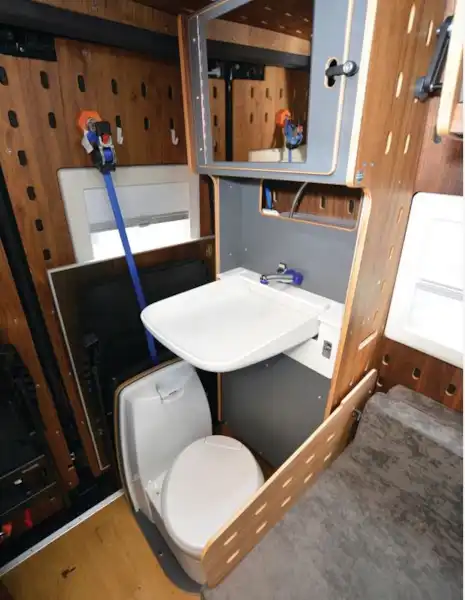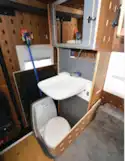Key Features
| Model Year | 2021 |
| Class | High top |
| Base Vehicle | MAN |
| Price From (£) | 70,000 |
| Length (m) | 5.97 |
| Berths | 2 |
| Belted Seats | 2 |
| Main Layout | Campervan |
At a glance
Full review
Images courtesy of CargoClips
We’ve seen campervans with removable furniture before. Indeed, the Editor’s HemBil Volkswagen has a cooker unit that comes out and a Reimo seat system that is – in theory at least, or if you’re very, very strong – a removable unit. This, though, is taking things a whole lot further. Not only is everything in the Cargo Camper designed to come out, it can also be reconfigured to suit your needs.
Made in Austria, but with newly set-up warehouse and sales support in the UK, CargoClips started off targeting the commercial vehicle market with tool boxes, etc, for vans, before moving into the camping sector. In fact, the origins of the business go back to manufacturing and repairing church organs – hence a history steeped in the best-quality wood, combined with high-end craftsmanship.
The move into campervans started four years ago and the company relocated to its current premises near Salzburg in 2019. Cargo Campers have been displayed at various leisure vehicle exhibitions in Germany but, now, with production growing towards a target of six vehicles per week, exports are starting – including to the UK.
This isn’t just a campervan with a twist, though, but a different concept, aimed at a different buyer. Cargo Camper customers are expected to lead an active lifestyle and want to carry kayaks or expensive mountain bikes inside their vehicles. They may need a van during the week, perhaps adding a bulkhead into the vehicle. Some buyers may even rearrange their ’van from weekday to weekend mode every Friday, because the system is so flexible and every unit removable.
PERFECT PERFORATIONS
Every Cargo Camper is based around a panel van lined out with the company’s distinctive perforated panelling, to which all the components of the conversion are secured using CargoClips’ unique locking bolts that simply twist into place – no tools are needed. At first made solely in orange for visibility in the commercial world then envisaged, these bolts now also come in grey or green, while the recesses they affix to are CNCd for accuracy.
There’s a choice of wood for the vehicle lining, too, with walnut joining the standard beech of the first conversions. To ensure quality and sustainability, all the wood is sourced from Swiss forestry, while every component is made in-house if possible. Seat/bed foam and fabrics are sourced locally in Austria, while no MDF is used and synthetic materials are avoided wherever possible. There’s a very Teutonic impression of overengineering throughout and the whole system is TÜV approved, so safety is assured. Every vehicle is built to order, with the interior panelling designed to suit the base vehicle chosen and its windows.
In Germany, the conversion is approved by MAN for its TGE van but this is by no means the only base vehicle option. Other large panel vans, such as the Fiat Ducato, Mercedes Sprinter, Peugeot Boxer and Renault Master can have the Cargo Camper treatment, although Eduard Sparkes, who is fronting the UK operation, believes the smaller VW Transporter could be the mainstay here because it is such a popular vehicle.
On the Continent, 4x4 vans have proved popular with the Cargo Camper’s outdoor lifestyle buyers. CargoClips will be able to supply UK-spec right-hand drive vehicles direct to the customer or buyers could choose to collect their camper from the factory. Conversions on existing vans will also be possible.
BESPOKE BUILD
Buyers can then select everything from a fully kitted out camper to simply a van that has been panelled out, ready to take Cargo Camper modules at a later date. The system has been designed – rather like Lego – so that the fixings never change and you can continue to change the vehicle, adding new elements, even in 20 years’ time.
The quality of the conversion is such that it is expected to outlive the base vehicle and buyers are anticipated to retain their conversion components when moving to a newer van, even if they are swapping, say, from a MAN to a Mercedes. As Eduard points out, you take your furniture with you when you move house, so why not adopt the same approach with your campervan?
A major part of the Cargo Camper’s appeal is also being able to have one vehicle that does everything, thus saving you money on road tax, servicing, insurance, etc. Your camper can be a van, or even a minibus, when required, before changing seamlessly into a leisure role. There’s a huge choice of different modules available, with more designs being added all the time. The company even says it will sit down and create special units if you have particular needs that are not currently serviced.
However, with five different kitchen modules (prices from just under €2,000), three fridge sizes (modules from €992), and three options for toilet facilities (from €290 to €1,861), for example, it should already have an answer for most buyers – just don’t expect a Cargo Camper to ever have a look like your typical cosy caravan-style interior. What you might find instead is a loading system to get bikes or motorbikes inside the vehicle, while an online configurator will show you what’s possible (and what your camper will weigh).
ONE WE PREPARED EARLIER
In the best Blue Peter tradition, CargoClips didn’t just talk the talk but showed us a completed vehicle – a demo model from Austria that was doing a UK tour. Based on the six-metre, high-roof MAN, this is a vehicle designed to display just some of the possibilities in a Cargo Camper. It also shows that this level of quality and ingenuity doesn’t come cheap – a fully converted MAN to this spec is likely to retail here at close to £70k. So, what do you get for that outlay?
Well, the interior layout looks straightforward, even if the décor and design do not. There are swivel cab seats and a long side settee facing the galley, while a fridge and cassette toilet sit on opposite sides just inside the rear barn doors (which carry outdoor chairs and table, securely strapped in place – using clips, naturally).
Above/behind the loo, in the left-hand rear corner – although, of course, it could have been sited elsewhere – is the Washbasin Module, with mirror-fronted storage and a folding basin. Here, though, you start to understand the complexity of having everything removable as each unit has to be self- contained, so that means incorporating a 20-litre fresh water supply, a second container for waste water and the 3-litre 12V/230V boiler, if required. As with even the 90-litre compressor fridge opposite, it has a simple plug-in connection to the vehicle’s 12V electrics, too. However, the more back-to- basics approach to the Cargo Camper shows in that the washing/toilet area is simply made private with a curtain – there’s no separate bathroom, although a portable shower (for use inside or outside the ’van) is possible.
THE KITCHEN
The kitchen also has its own water supply for the sink, while cooking in this model is on a portable single-burner stove stored in a drawer. An induction hob is also available, as are alternative worktop finishes, but what you won’t find here are the usual caravan industry cupboard catches – instead, the leather tags to open the lockers seem far more appropriate to the ethos of this ’van. Cutlery isn’t in a drawer but a fold-down utensil holder with foam surround to hold everything silently in place as you drive. Even the spice rack is a wooden work of art.
THE BED
More conventional is the side sofa that simply unfolds into a completely flat 1.91m by 1.32m double bed and the swivel cab seats that you use for dining, although the table that folds flat to the wall and secures magnetically eschews the traditional approach. And these, again, are just examples of what’s on offer. Removable individual travel seats can be supplied, fitted to a floor rail system, so the Cargo Camper can be up to a six-seater. Or there’s the Bed and Breakfast Module that combines a pair of simple seats and a table, as well as a double bed, all of which folds flat to the wall so that you have more load space available for bikes, or whatever.
Of course, there’s nothing as conventional as a wardrobe in this ’van – instead what looks like the BFG’s wooden comb hinges down from the ceiling to hold coats, either on hangers or their own hooks. Even the reading light is a one-of-a-kind design that can slot into any of those recesses in the wall, although fittings like the diesel heating and roll-out awning are typical campervan items.
SUMMARY
One thing’s for certain, no two Cargo Campers are ever likely to look the same (maybe not even the same from one week to the next!), and nor will they ever have the appearance of a conventional campervan. For those who want more versatility and maybe even a weekday work van, however, this could be a unique solution.
Expert motorhome advice to your door!
Why not subscribe to one of our fabulous magazines and get expert advice, travel ideas, technical help and all the latest news for your motorhome and your motorhome adventures!
Want to know more about MMM magazine?
Every month MMM has articles written by motorhomers who have been there and done it, from great UK and European (and further afield) tours, campsite reviews, owners' reports and DIY projects among other things. MMM's tests, reviews and expert buying guides are not to be missed. MMM's technical advice is a must and includes everything from weekend jobs to longer-term DIY projects. And much more!
About MMM magazineWant to know more about What Motorhome magazine?
Every issue of What Motorhome magazine provides essential buying advice for anyone looking to buy a new motorhome or campervan or upgrade their existing model. With a pedigree of over 30 years of offering the best motorhome and campervan buying advice, every issue of What Motorhome includes more new motorhome and campervan reviews than you will find in any other magazine.
About What MotorhomeWant to know more about Campervan magazine?
Campervan is the exciting monthly magazine that will give you all the inspiration you need to explore the world in your campervan. Every issue is packed with real-life campervanning experiences, inspiring travel ideas in the UK and further afield, the best campsites to stay on, campervan road tests and reviews of the latest models, and much more!
About Campervan magazine

